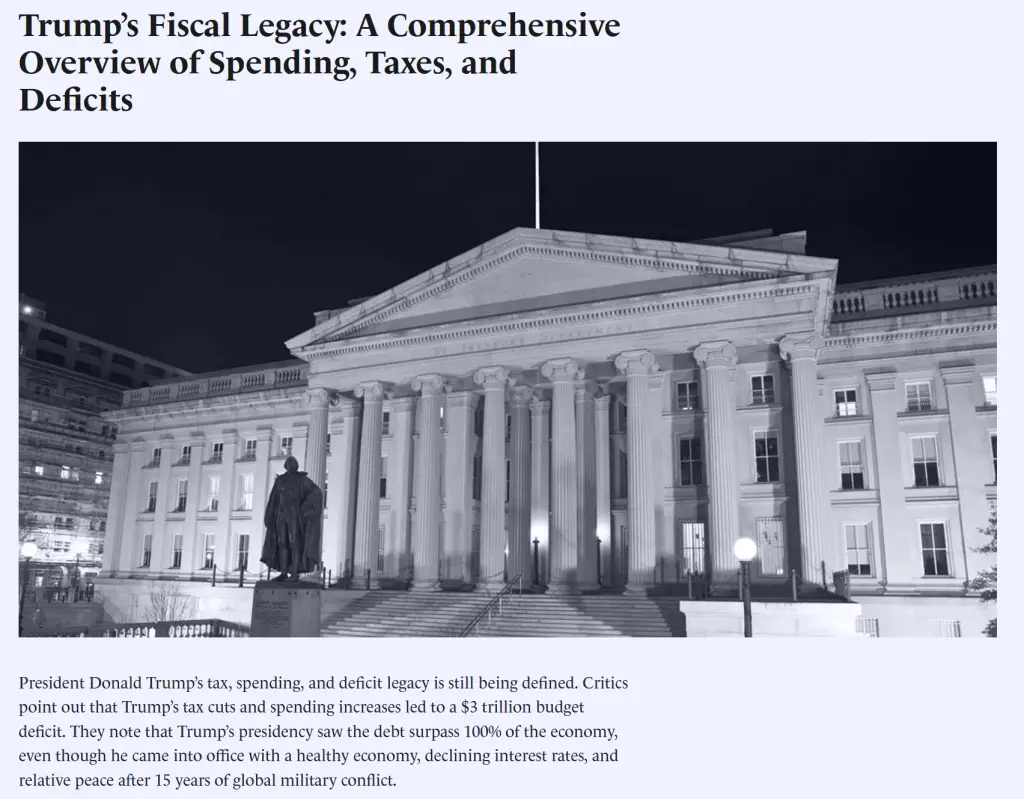During the first few years of Trump’s presidency, the U.S. economy experienced noticeable growth. This period was characterized by policies such as significant corporate tax cuts and maintaining low-interest rates.
The Tax Cuts and Jobs Act (TCJA) of 2017 was one of the most significant legislative achievements of the Trump administration, aimed at overhauling the tax system to stimulate economic growth.
This legislation introduced sweeping tax cuts, particularly for corporations, reducing the corporate tax rate from 35% to 21%. For individuals, the act adjusted tax brackets, resulting in modest increases in take-home pay for many Americans.
While these measures drove short-term economic expansion and maintained a robust economy inherited from the previous administration, they also laid the groundwork for potential long-term challenges.
The substantial tax cuts contributed to a rise in the federal deficit, reducing the government’s flexibility to respond to future economic crises.
Challenges in Stimulating the Economy During Crises
The economic strategies employed by the Trump administration left little room for maneuvering during unforeseen crises.
When the COVID-19 pandemic hit, the pre-existing high levels of deficit spending limited the government’s ability to engage in additional deficit spending to replace the plummeting consumer demand.
The fiscal space required for an effective stimulus was already constrained, making the pandemic’s economic impact particularly severe.
Consider the experience of John Smith, a small business owner in Tampa, Florida. Before the pandemic, John’s business thrived, partly due to the economic boost from the initial tax cuts and favorable business conditions.
#dropoutdon
However, when COVID-19 struck, his sales dropped drastically. The government responded with stimulus measures, but the already high deficit made it challenging to provide sufficient support.
The Paycheck Protection Program (PPP) loans he received helped temporarily, but they weren’t enough to sustain his business through prolonged periods of low consumer spending. John found himself struggling to keep his employees on payroll and cover basic operational costs.
The limited fiscal flexibility, a consequence of prior deficit spending, meant that the government’s ability to support small businesses like John’s was severely hampered, highlighting the long-term drawbacks of prioritizing short-term economic gains over sustainable fiscal policies.

Prioritizing Headlines Over Fiscal Responsibility
Trump’s administration focused on generating positive economic headlines to boost stock market performance and tout the economy as the best ever.
This approach often came at the expense of sound fiscal management.
Instead of preparing the nation’s financial house for potential downturns, the administration’s policies left the economy vulnerable when a significant economic disturbance occurred.
The Economic Consequences of COVID-19
The arrival of the COVID-19 pandemic exposed the vulnerabilities of the U.S. economy under Trump’s policies.
The combination of pre-existing deficit spending and the need for substantial economic stimulus led to enormous expenses that will have long-lasting impacts.
The pandemic’s economic fallout highlighted the risks associated with prioritizing short-term growth without considering the need for flexibility to address major economic disruptions.
Most people’s tax cuts amounted to an extra $50 to $100 a month. These tax cuts are set to expire and will gradually increase until 2027, meaning that individuals will face higher taxes over time.
The Long-Term Impact of Trump’s Economic Policies
The economic decisions made during Trump’s presidency will influence the U.S. economy for years to come.
The increased national debt and the fiscal challenges posed by the COVID-19 pandemic underscore the importance of balancing short-term economic gains with long-term stability and preparedness.
Future administrations will need to navigate these challenges while addressing the lingering effects of the economic policies implemented during Trump’s tenure.
During Trump’s presidency, significant changes were made to the U.S. tax code through the Tax Cuts and Jobs Act (TCJA) of 2017.
The act introduced various tax cuts, including reductions in corporate tax rates and adjustments to individual tax brackets.
However, the impact of these tax cuts on individuals varied widely, and many of the benefits were skewed towards corporations and high-income earners.
For most individuals, the tax cuts translated to an additional $50 to $100 per month in their paychecks.
These individual tax cuts, however, are set to expire by 2027, after which tax rates will gradually increase each year.
This means that while there was a short-term boost in take-home pay for many Americans, they will face higher tax rates in the future.
Moreover, income growth slowed under Trump‘s administration, which meant that the tax cuts did not lead to significant or sustained increases in wages for most workers.
Instead, many corporations used the financial windfall from the tax cuts to buy back their own stock.
Stock buybacks can drive up share prices, benefiting shareholders and corporate executives more than the average worker.
This strategy tends to enrich the wealthiest individuals who own the majority of the stock market, exacerbating income inequality.
Conclusion: The Lingering Effects of Trump’s Tax Policies
Most people’s tax cuts amounted to an extra $50 to $100 a month. These tax cuts are set to expire and will gradually increase until 2027, meaning that individuals will face higher taxes over time.
Income growth slowed under Trump, and many corporations used their tax cuts for stock buybacks, which enriched the wealthy more than anyone else.
While the corporate tax cuts are permanent, the temporary nature of the individual tax cuts means that the financial burden on everyday Americans will increase, highlighting the uneven distribution of benefits from the tax policies enacted during Trump’s presidency.